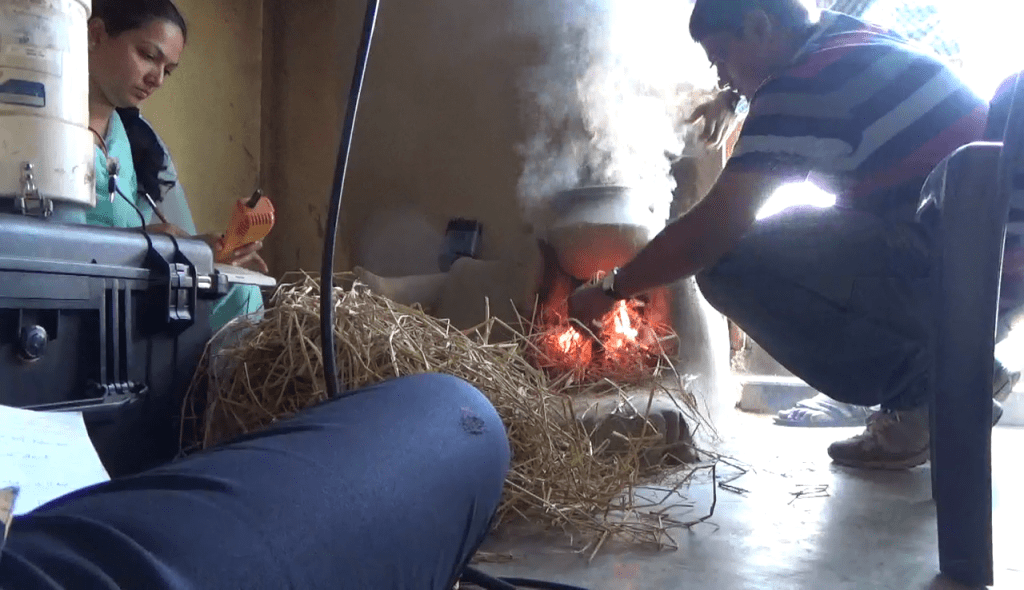We evaluate aerosol-radiation interactions in the atmosphere and the cryosphere by estimating direct forcing efficiencies and radiative forcing. We incorporate field and laboratory optical property data in our models and utilize tools such as libRadtran, SNICAR and WRF-Chem. Our studies have previously covered radiative forcing due to brown carbon aerosols from the burning of boreal peatlands. Recent work has focused on predictions of snow surface radiative forcing due to dark brown carbon deposition from wildfires. Information on some studies are shared below.
Dr. Chakrabarty’s group has conducted several field studies (with Indian scientists) to assess the impact of carbonaceous aerosol on radiative forcing over that region. Their comprehensive findings have led to the conclusion that the carbon mass fractions and their profiles of carbonaceous aerosols are markedly different from those reported in past literature − including the source profiles used as inputs to receptor modelling studies conducted by the Central Pollution Control Board of India (equivalent of US EPA). In particular, high-molecular and thermally-stable organic carbon contributes nearly 50% of the total carbon mass for emissions from various sources over that region. These organics (some of which are brown carbon) are currently in the process of being taken into account by current emission inventory compilers, health-effects regulatory programs, and policy makers in India.

Dr. Chakrabarty’s research found, for the first time, distressingly high Black Carbon (BC) aerosol levels in the Brahmaputra river valley (BRV) region of South Asia that are causing an outflow of BC pollution into the Himalayas. His results showed that the blanket effect of BC aerosols over the region resulted in a temperature rise of two degrees Kelvin more than what it would have been without the aerosols. To verify this seminal and startling finding, the Government of India funded the Cloud Aerosol Interaction and Precipitation Enhancement Experiment (CAIPEEX) airborne campaign to assess the role of BC over BRV region. This aircraft study indeed verified Dr. Chakrabarty’s radiative forcing calculations and found agreement with his estimates of 2K/day atmospheric heating over BRV.

Relevant Publications:
- Chakrabarty, R. K., Gyawali, M., Yatavelli, R. L. N., Pandey, A., Watts, A. C., Knue, J., Chen, L.-W. A., Pattison, R. R., Tsibart, A., Samburova, V., & Moosmüller, H. (2016). Brown carbon aerosols from burning of boreal peatlands: Microphysical properties, emission factors, and implications for direct radiative forcing. Atmospheric Chemistry and Physics, 16(5), 3033–3040. https://doi.org/10.5194/acp-16-3033-2016.
- Chakrabarty, R. K., Shetty, N. J., Thind, A. S., Beeler, P., Sumlin, B. J., Zhang, C., Liu, P., Idrobo, J. C., Adachi, K., Wagner, N. L., Schwarz, J. P., Ahern, A., Sedlacek, A. J., Lambe, A., Daube, C., Lyu, M., Liu, C., Herndon, S., Onasch, T. B., & Mishra, R. (2023). Shortwave absorption by wildfire smoke dominated by dark brown carbon. Nature Geoscience, 16(8), Article 8. https://doi.org/10.1038/s41561-023-01237-9.
- Luo, J., Li, Z., Zhang, C., Zhang, Q., Zhang, Y., Zhang, Y., Curci, G., & Chakrabarty, R. K. (2022). Regional impacts of black carbon morphologies on shortwave aerosol–radiation interactions: A comparative study between the US and China. Atmospheric Chemistry and Physics, 22(11), 7647–7666. https://doi.org/10.5194/acp-22-7647-2022
- Chakrabarty, R. K., S. Pervez, J.C. Chow, J. G. Watson, S. Dewangan, J. Robles, and G. Tian (2014). “Funeral Pyres in India: Brown Carbon Aerosol Emissions and Climate Impacts”. Environ. Sci. Technol. Letters, DOI: 10.1021/ez4000669
- Chakrabarty, R. K., M. A. Garro, E. M. Wilcox, and H. Moosmüller (2012). Strong Radiative Heating due to Wintertime Black Carbon Aerosols in the Brahmaputra River Valley. Geophys. Res. Lett., 39, doi:10.1029/2012GL051148.